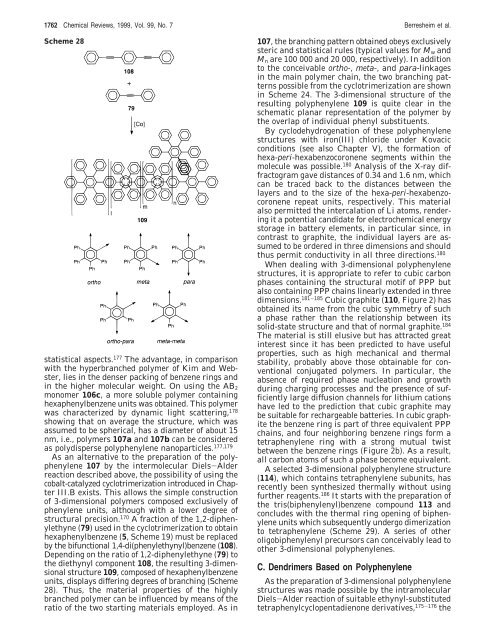Polyphenylene Nanostructures - Cluster for Molecular Chemistry
Polyphenylene Nanostructures - Cluster for Molecular Chemistry
Polyphenylene Nanostructures - Cluster for Molecular Chemistry
You also want an ePaper? Increase the reach of your titles
YUMPU automatically turns print PDFs into web optimized ePapers that Google loves.
1762 Chemical Reviews, 1999, Vol. 99, No. 7 Berresheim et al.<br />
Scheme 28<br />
statistical aspects. 177 The advantage, in comparison<br />
with the hyperbranched polymer of Kim and Webster,<br />
lies in the denser packing of benzene rings and<br />
in the higher molecular weight. On using the AB2<br />
monomer 106c, a more soluble polymer containing<br />
hexaphenylbenzene units was obtained. This polymer<br />
was characterized by dynamic light scattering, 178<br />
showing that on average the structure, which was<br />
assumed to be spherical, has a diameter of about 15<br />
nm, i.e., polymers 107a and 107b can be considered<br />
as polydisperse polyphenylene nanoparticles. 177,179<br />
As an alternative to the preparation of the polyphenylene<br />
107 by the intermolecular Diels-Alder<br />
reaction described above, the possibility of using the<br />
cobalt-catalyzed cyclotrimerization introduced in Chapter<br />
III.B exists. This allows the simple construction<br />
of 3-dimensional polymers composed exclusively of<br />
phenylene units, although with a lower degree of<br />
structural precision. 170 A fraction of the 1,2-diphenylethyne<br />
(79) used in the cyclotrimerization to obtain<br />
hexaphenylbenzene (5, Scheme 19) must be replaced<br />
by the bifunctional 1,4-di(phenylethynyl)benzene (108).<br />
Depending on the ratio of 1,2-diphenylethyne (79) to<br />
the diethynyl component 108, the resulting 3-dimensional<br />
structure 109, composed of hexaphenylbenzene<br />
units, displays differing degrees of branching (Scheme<br />
28). Thus, the material properties of the highly<br />
branched polymer can be influenced by means of the<br />
ratio of the two starting materials employed. As in<br />
107, the branching pattern obtained obeys exclusively<br />
steric and statistical rules (typical values <strong>for</strong> Mw and<br />
Mn are 100 000 and 20 000, respectively). In addition<br />
to the conceivable ortho-, meta-, and para-linkages<br />
in the main polymer chain, the two branching patterns<br />
possible from the cyclotrimerization are shown<br />
in Scheme 24. The 3-dimensional structure of the<br />
resulting polyphenylene 109 is quite clear in the<br />
schematic planar representation of the polymer by<br />
the overlap of individual phenyl substituents.<br />
By cyclodehydrogenation of these polyphenylene<br />
structures with iron(III) chloride under Kovacic<br />
conditions (see also Chapter V), the <strong>for</strong>mation of<br />
hexa-peri-hexabenzocoronene segments within the<br />
molecule was possible. 180 Analysis of the X-ray diffractogram<br />
gave distances of 0.34 and 1.6 nm, which<br />
can be traced back to the distances between the<br />
layers and to the size of the hexa-peri-hexabenzocoronene<br />
repeat units, respectively. This material<br />
also permitted the intercalation of Li atoms, rendering<br />
it a potential candidate <strong>for</strong> electrochemical energy<br />
storage in battery elements, in particular since, in<br />
contrast to graphite, the individual layers are assumed<br />
to be ordered in three dimensions and should<br />
thus permit conductivity in all three directions. 180<br />
When dealing with 3-dimensional polyphenylene<br />
structures, it is appropriate to refer to cubic carbon<br />
phases containing the structural motif of PPP but<br />
also containing PPP chains linearly extended in three<br />
dimensions. 181-185 Cubic graphite (110, Figure 2) has<br />
obtained its name from the cubic symmetry of such<br />
a phase rather than the relationship between its<br />
solid-state structure and that of normal graphite. 184<br />
The material is still elusive but has attracted great<br />
interest since it has been predicted to have useful<br />
properties, such as high mechanical and thermal<br />
stability, probably above those obtainable <strong>for</strong> conventional<br />
conjugated polymers. In particular, the<br />
absence of required phase nucleation and growth<br />
during charging processes and the presence of sufficiently<br />
large diffusion channels <strong>for</strong> lithium cations<br />
have led to the prediction that cubic graphite may<br />
be suitable <strong>for</strong> rechargeable batteries. In cubic graphite<br />
the benzene ring is part of three equivalent PPP<br />
chains, and four neighboring benzene rings <strong>for</strong>m a<br />
tetraphenylene ring with a strong mutual twist<br />
between the benzene rings (Figure 2b). As a result,<br />
all carbon atoms of such a phase become equivalent.<br />
A selected 3-dimensional polyphenylene structure<br />
(114), which contains tetraphenylene subunits, has<br />
recently been synthesized thermally without using<br />
further reagents. 186 It starts with the preparation of<br />
the tris(biphenylenyl)benzene compound 113 and<br />
concludes with the thermal ring opening of biphenylene<br />
units which subsequently undergo dimerization<br />
to tetraphenylene (Scheme 29). A series of other<br />
oligobiphenylenyl precursors can conceivably lead to<br />
other 3-dimensional polyphenylenes.<br />
C. Dendrimers Based on <strong>Polyphenylene</strong><br />
As the preparation of 3-dimensional polyphenylene<br />
structures was made possible by the intramolecular<br />
Diels-Alder reaction of suitable ethynyl-substituted<br />
tetraphenylcyclopentadienone derivatives, 175-176 the

















